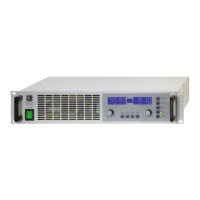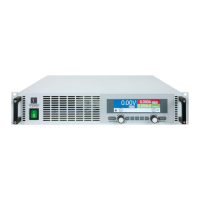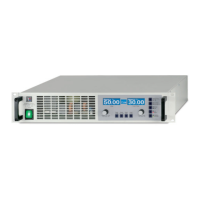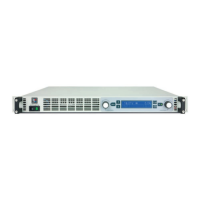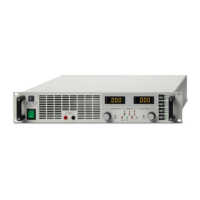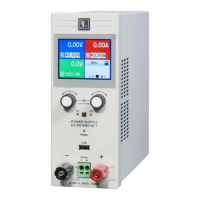Do you have a question about the Elektro-Automatik PS 2000 B Triple Series and is the answer not in the manual?
Document purpose and retention guidelines.
Details the warranty period and conditions for the device.
EA Elektro-Automatik's liability limitations and disclaimers.
Instructions for the environmentally friendly disposal of the equipment.
Explains how to interpret the product identification label and its components.
Defines the specific applications and intended use cases for the device.
Comprehensive safety guidelines and precautions for operating the device.
Critical safety warnings and essential precautions for safe operation.
Outlines the user's responsibilities for safe operation and maintenance.
Details the operator's duties to ensure safe usage and compliance.
Specifies the necessary qualifications and requirements for operating personnel.
Explains the various alarm signals and their meanings for device status.
Provides a detailed overview of the device's technical specifications.
Specifies the recommended environmental and operational conditions for use.
Lists general technical parameters such as display type and control elements.
Presents detailed technical specifications for different PS 2000 B Triple models.
Visual diagrams of the device's front and rear panels with key components.
Overview of the series' compact design and suitability for educational settings.
Lists the standard items included with the power supply unit.
Information on additional accessories available for purchase and use.
Detailed description of the Human Machine Interface (HMI) panels.
Explains the structure and information displayed on the HMI screen.
Functionality and usage of the rotary knobs for adjustment and navigation.
Describes the push-button capabilities of the rotary knobs for cursor movement.
Details the step width and number of digits for value adjustments.
Guidelines for proper storage of the device and its packaging.
Recommendations for retaining transport packaging for future needs.
Best practices for long-term storage to prevent humidity damage.
Procedure for inspecting the device after unpacking for damage or completeness.
Steps and safety procedures necessary for installing the power supply.
Critical safety precautions to follow before connecting and operating the device.
Pre-installation steps, including mains and DC load wiring considerations.
Guidelines for selecting an appropriate installation location and ensuring ventilation.
Proper methods for connecting DC loads and cable selection advice.
Instructions on how to properly ground the DC output terminals.
Guidance on connecting the device to a PC using the USB interface.
Steps for installing necessary drivers on Windows operating systems.
Information regarding driver availability for Linux and MacOS platforms.
Advice on sourcing alternative drivers if default ones are unavailable.
Essential safety measures required for personnel operating the device.
Explanation of the different operating modes and their characteristics.
Describes the Constant Voltage (CV) mode and its operational behavior.
Details voltage settling time following a change in load conditions.
Covers Constant Current (CC) mode and the function of current limitation.
Explains how the device manages power output to prevent exceeding limits.
An overview of the device's alarm conditions and indicators.
Describes the Over Temperature (OT) alarm and its causes.
Details the Over Voltage (OVP) alarm and its implications for the device and load.
Explains the Over Current Protection (OCP) alarm and its role in safeguarding the load.
Step-by-step instructions for powering the device on.
Step-by-step instructions for powering the device on.
Procedures for powering down the device and preserving settings.
Guidance on navigating and utilizing the device's setup menu for configuration.
Configuration options for output parameters, protection thresholds, and limits.
Displays essential device information, including serial number and firmware versions.
Options for customizing the Human Machine Interface (HMI) settings.
Function to activate or deactivate the tracking mode for synchronized output control.
How to configure upper limits for voltage and current adjustments to protect applications.
Detailed guide on manually adjusting voltage and current using the rotary knobs.
Methods for manually and remotely controlling the DC output state.
Instructions for locking and unlocking the HMI to prevent unauthorized adjustments.
Master-slave operation for outputs 1 and 2, enabling synchronized control.
Procedure for connecting outputs 1 and 2 in series to increase output voltage.
Key limitations and considerations when using series connection.
Procedure for connecting outputs 1 and 2 in parallel to increase output current.
Specific details and operational characteristics of the auxiliary third output.
Information about the dedicated Windows software for remote device operation.
Information about the dedicated Windows software for remote device operation.
Details on programming the device and its communication protocols.
Information regarding the EasyPS2000 software for device control.
How the device signals, handles, and logs alarms and events.
How the device signals, handles, and logs alarms and events.
Guidelines for routine maintenance and cleaning of the device.
Procedures for identifying, diagnosing, and addressing faults.
Instructions on how to safely replace a blown mains fuse.
Guidance on performing firmware updates to improve device functionality.
Information and procedures concerning equipment repairs.
Contact information for technical support and customer service.
Document purpose and retention guidelines.
Details the warranty period and conditions for the device.
EA Elektro-Automatik's liability limitations and disclaimers.
Instructions for the environmentally friendly disposal of the equipment.
Explains how to interpret the product identification label and its components.
Defines the specific applications and intended use cases for the device.
Comprehensive safety guidelines and precautions for operating the device.
Critical safety warnings and essential precautions for safe operation.
Outlines the user's responsibilities for safe operation and maintenance.
Details the operator's duties to ensure safe usage and compliance.
Specifies the necessary qualifications and requirements for operating personnel.
Explains the various alarm signals and their meanings for device status.
Provides a detailed overview of the device's technical specifications.
Specifies the recommended environmental and operational conditions for use.
Lists general technical parameters such as display type and control elements.
Presents detailed technical specifications for different PS 2000 B Triple models.
Visual diagrams of the device's front and rear panels with key components.
Overview of the series' compact design and suitability for educational settings.
Lists the standard items included with the power supply unit.
Information on additional accessories available for purchase and use.
Detailed description of the Human Machine Interface (HMI) panels.
Explains the structure and information displayed on the HMI screen.
Functionality and usage of the rotary knobs for adjustment and navigation.
Describes the push-button capabilities of the rotary knobs for cursor movement.
Details the step width and number of digits for value adjustments.
Guidelines for proper storage of the device and its packaging.
Recommendations for retaining transport packaging for future needs.
Best practices for long-term storage to prevent humidity damage.
Procedure for inspecting the device after unpacking for damage or completeness.
Steps and safety procedures necessary for installing the power supply.
Critical safety precautions to follow before connecting and operating the device.
Pre-installation steps, including mains and DC load wiring considerations.
Guidelines for selecting an appropriate installation location and ensuring ventilation.
Proper methods for connecting DC loads and cable selection advice.
Instructions on how to properly ground the DC output terminals.
Guidance on connecting the device to a PC using the USB interface.
Steps for installing necessary drivers on Windows operating systems.
Information regarding driver availability for Linux and MacOS platforms.
Advice on sourcing alternative drivers if default ones are unavailable.
Essential safety measures required for personnel operating the device.
Explanation of the different operating modes and their characteristics.
Describes the Constant Voltage (CV) mode and its operational behavior.
Details voltage settling time following a change in load conditions.
Covers Constant Current (CC) mode and the function of current limitation.
Explains how the device manages power output to prevent exceeding limits.
An overview of the device's alarm conditions and indicators.
Describes the Over Temperature (OT) alarm and its causes.
Details the Over Voltage (OVP) alarm and its implications for the device and load.
Explains the Over Current Protection (OCP) alarm and its role in safeguarding the load.
Step-by-step instructions for powering the device on.
Step-by-step instructions for powering the device on.
Procedures for powering down the device and preserving settings.
Guidance on navigating and utilizing the device's setup menu for configuration.
Configuration options for output parameters, protection thresholds, and limits.
Displays essential device information, including serial number and firmware versions.
Options for customizing the Human Machine Interface (HMI) settings.
Function to activate or deactivate the tracking mode for synchronized output control.
How to configure upper limits for voltage and current adjustments to protect applications.
Detailed guide on manually adjusting voltage and current using the rotary knobs.
Methods for manually and remotely controlling the DC output state.
Instructions for locking and unlocking the HMI to prevent unauthorized adjustments.
Master-slave operation for outputs 1 and 2, enabling synchronized control.
Procedure for connecting outputs 1 and 2 in series to increase output voltage.
Key limitations and considerations when using series connection.
Procedure for connecting outputs 1 and 2 in parallel to increase output current.
Specific details and operational characteristics of the auxiliary third output.
Information about the dedicated Windows software for remote device operation.
Information about the dedicated Windows software for remote device operation.
Details on programming the device and its communication protocols.
Information regarding the EasyPS2000 software for device control.
How the device signals, handles, and logs alarms and events.
How the device signals, handles, and logs alarms and events.
Guidelines for routine maintenance and cleaning of the device.
Procedures for identifying, diagnosing, and addressing faults.
Instructions on how to safely replace a blown mains fuse.
Guidance on performing firmware updates to improve device functionality.
Information and procedures concerning equipment repairs.
Contact information for technical support and customer service.
| Number of Outputs | 3 |
|---|---|
| Voltage Resolution | 1 mV |
| Storage Temperature Range | -20 °C to +70 °C |
| Current Programming Accuracy | ±0.1% of set value + 5 mA |
| Current Measurement Accuracy | ±0.1% of reading + 5 mA |
| Operating Temperature Range | 0 °C to +50 °C, derating > 40 °C |
| Protections | Overvoltage, Overcurrent, Overtemperature |
| Interface | USB |
